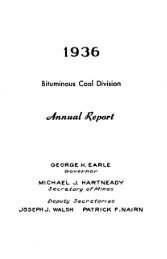Reports of the Inspectors of Mines of the anthracite coal regions of ...
Reports of the Inspectors of Mines of the anthracite coal regions of ...
Reports of the Inspectors of Mines of the anthracite coal regions of ...
Create successful ePaper yourself
Turn your PDF publications into a flip-book with our unique Google optimized e-Paper software.
Ex. Doc] <strong>Reports</strong> <strong>of</strong> <strong>the</strong> <strong>Inspectors</strong> or <strong>Mines</strong>. 177<br />
twenty-five feet wide, and up thirty feet from tlie gangway, pitching about<br />
5°. The top rock is very good at <strong>the</strong> place <strong>of</strong> <strong>the</strong> accident. A thin slate<br />
adheres to <strong>the</strong> rock in some places, which requires centerpropping, and at<br />
<strong>the</strong> scene <strong>of</strong> <strong>the</strong> accident this had been satisfactorily done by <strong>the</strong> deceased.<br />
His laborer, who was loading <strong>the</strong> car at <strong>the</strong> time, came near sharing <strong>the</strong><br />
same fate.<br />
Accident No. 15 on <strong>the</strong> list, Barney McTauge, miner, aged 35, fatally<br />
injured by a fall <strong>of</strong> <strong>coal</strong> at Lattimer colliery, August 25, 1877. The de-<br />
ceased was about to drill a hole in <strong>the</strong> four-foot bench, when about a ton<br />
<strong>of</strong> <strong>the</strong> two-foot bench fell on him, crushing him so severely that he died<br />
in two hours after he had been taken home. The breast was driven one<br />
hundred and twenty feet up <strong>the</strong> pitch from <strong>the</strong> gangway, and thirty feet<br />
wide. The <strong>coal</strong> was <strong>of</strong> a slippery nature, but not <strong>of</strong> a deceiving char-<br />
acter, as sometimes happens to be. In m}' estimation, a safer place to<br />
work could not be found, as <strong>the</strong> breast was driven up in line with an air<br />
hole, affording a very safe retreat for <strong>the</strong> men in case <strong>of</strong> danger.<br />
Accident No. 16 on <strong>the</strong> list, John Quinn, aged 44, instantly killed by a<br />
fall <strong>of</strong> <strong>coal</strong> <strong>of</strong>i" <strong>the</strong>. pillar, at upper Lehigh collier}-, September 11, 1877.<br />
The breast was twenty-one feet wide and forty-five feet up from <strong>the</strong><br />
gangway. The top rock, or ro<strong>of</strong>, was very bad in this breast, which<br />
necessitated center-props to be stood every six feet, which is a thing<br />
seldom required in <strong>the</strong> Buck Mountain vein, as <strong>the</strong> top I'ock is <strong>of</strong> ex-<br />
traordinary hardness. The lump <strong>of</strong> <strong>coal</strong> which fell on <strong>the</strong> deceased<br />
ought to have been taken down before he advanced too far on <strong>the</strong> face <strong>of</strong><br />
his working, but, unfortunately for him, he left it, as he supposed, as a<br />
support for <strong>the</strong> ro<strong>of</strong>, instead <strong>of</strong> standing a pi'op, (as stated by ano<strong>the</strong>r<br />
miner, to whom he told his intentions.) A great many accidents occur by<br />
leaving hangings on <strong>the</strong> pillars, that could be trimmed <strong>of</strong>f, and it is also<br />
an injury to <strong>the</strong> pillar to leave those wings on.<br />
Accident No. 18 on <strong>the</strong> list, Michael Boyle, aged 35, was fatally injured<br />
at No. 2, Council Ridge colliery, October 10, 1877. The deceased was<br />
laboring for a miner, in a breast. Considerable top <strong>coal</strong> had been left<br />
hanging, which was <strong>of</strong> a very treacherous character, and should have been<br />
taken down by <strong>the</strong> miner, who is censurable for not doing so, and it would<br />
be commendable if mine bosses would insist upon men removing <strong>the</strong> least<br />
suspicion <strong>of</strong> danger momentarily, and not to permit <strong>of</strong> an^- procrastina-<br />
tion. By doing so <strong>the</strong> men would be rewarded for <strong>the</strong>ir trouble, and <strong>the</strong><br />
company' compensated for <strong>the</strong> act.<br />
Undoubtedly, <strong>the</strong> miner's intention was to economise in <strong>the</strong> use <strong>of</strong> pow-<br />
der, by advancing as far as possible on <strong>the</strong> bottom <strong>coal</strong>, so that <strong>the</strong> top<br />
<strong>coal</strong> would require but little blasting. This, in my estimation, is a culpa-<br />
ble practice, and should strictly be forbidden by <strong>the</strong> mine bosses.<br />
Accident No. 19 on <strong>the</strong> list, Thomas Trelure, aged 28, was instantly<br />
killed by a fall <strong>of</strong> slate, in Cranberry colliery, October 23, 1877. The de-<br />
ceased, one <strong>of</strong> three, were employed at robbing an old counter-gangway,<br />
12 Mine Rep.




![1945 Anthracite Annual Report Districts 19 - 25 [Adobe pdf - 9148Kb]](https://img.yumpu.com/50308099/1/190x119/1945-anthracite-annual-report-districts-19-25-adobe-pdf-9148kb.jpg?quality=85)


![1937 Anthracite Annual Report Districts 1 - 11 [Adobe pdf - 9394Kb]](https://img.yumpu.com/43539962/1/190x119/1937-anthracite-annual-report-districts-1-11-adobe-pdf-9394kb.jpg?quality=85)







![1931 Anthracite Annual Report Districts 1 - 11 [Adobe pdf - 8007Kb]](https://img.yumpu.com/39427789/1/190x119/1931-anthracite-annual-report-districts-1-11-adobe-pdf-8007kb.jpg?quality=85)

